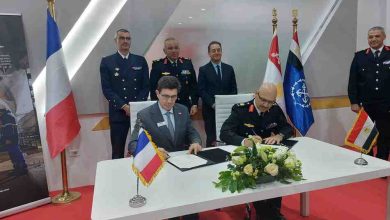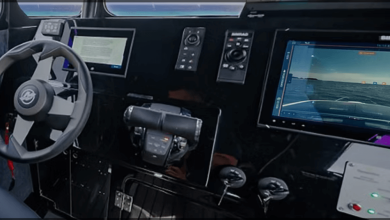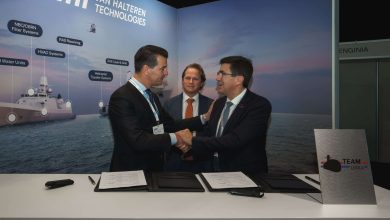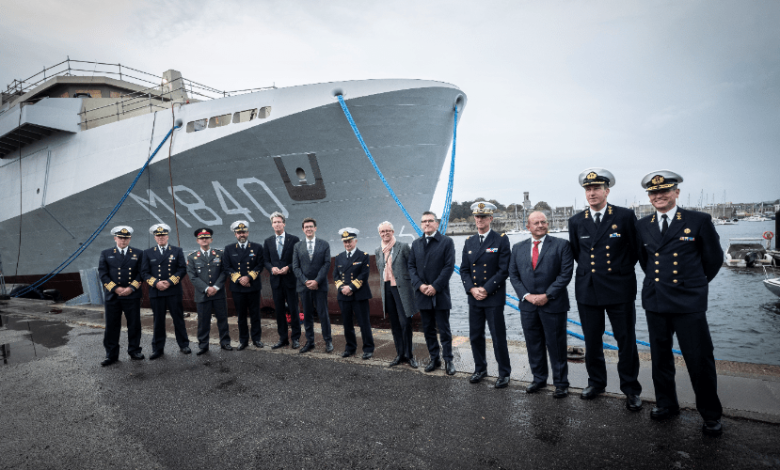
Unveiling the Vlissingen: The Latest Innovation in the Belgian-Dutch Mine Countermeasure Fleet
The inauguration event of the Vlissingen, the second of the twelve mine countermeasure vessels part of the Belgian-Dutch rMCM initiative, designed for the Royal Netherlands Navy, transpired on October 19th 2023 in Concarneau, attended by the Chiefs of Navy from both the Royal Netherlands Navy and the Belgian Navy, alongside a representative from the Chief of Staff of the French Navy. The launching was executed by Kership, which fabricates the vessels in Concarneau on behalf of Naval Group, the primary contractor.
This initiative was granted in 2019 to Belgium Naval & Robotics, a partnership created by Naval Group and Exail, following an international bidding process. It entails the provision of twelve mine countermeasures vessels and approximately one hundred drones, integrated within a toolbox designed to equip these vessels for the Belgian
Navy and the Royal Netherlands Navy.
Naval Group, as the principal architect and main contractor, is tasked with the design of the ships, the overall integration, and the testing and inauguration of the mission system (combat system and mine countermeasure system).
Kership, a joint venture between Naval Group and Piriou, oversees the construction of the twelve vessels, which are assembled in Concarneau and Lanester.
Exail, acting as co-contractor, manages the automated drones’ system. A majority of these drones will be created in Ostend, Belgium. The maintenance of the vessels will take place in Belgium through close collaboration between the Belgian Navy and Naval Group Belgium, aided by its partner Flanders Ship Repair.
The Vlissingen, the second vessel of the program and the first one designated for the Royal Netherlands Navy, is scheduled for delivery in 2025.
The inaugural vessel, Oostende, meant for the Belgian Navy, was launched on March 29th, 2023, while the keel for the third of the twelve vessels, the M941 Tournai, also intended for the Belgian Navy, was laid. The keel of the fourth vessel, the Scheveningen, the second ship intended for the Royal Netherlands Navy, was laid on July 19th, 2023.
The delivery of the Oostende is anticipated by the end of 2024 in Zeebrugge, Belgium. The delivery of the additional vessels will follow in a staggered manner until 2030.
Pierre Eric Pommellet, CEO of Naval Group remarked: « This vessel represents yet again the emblem of significant industrial collaboration, along with profound European cooperation. The Vlissingen is now unveiled less than 53 months after the contract was initiated. This achievement is the result of the joint efforts of the engineering teams from Naval Group, the production crews at Kership and the Piriou shipyard, alongside the teams from the Belgian and Dutch administrations, whom I wish to commend. »
An exceptional industrial and European partnership
The rMCM programme constitutes a critical component of European Defence. This initiative exemplifies how European nations can collaboratively address their requirements and share a solution set to establish a benchmark in the mine countermeasures domain, not only for the Belgian and Dutch navies but for other forces across Europe and the globe.
In September 2023, a Memorandum of Understanding (MoU) was formalized among France, Belgium, and the Netherlands. It grants France access to utilize the rMCM vessel design for its Navy. A total of 12+6 vessels are anticipated under these programs. Thales, which has been advancing the Franco-British MMCM unmanned mine countermeasures program since 2015, and is currently in testing phases at sea with both navies, will manage the integrated drone solution for France. This alliance further strengthens the collaboration between these three nations in the realm of mine warfare.
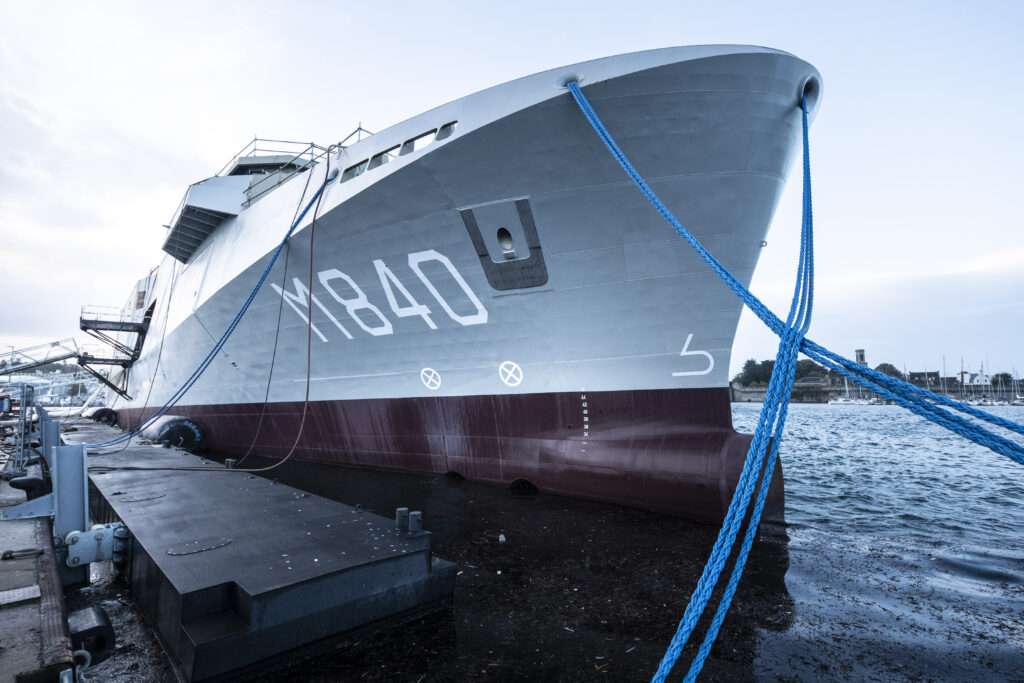

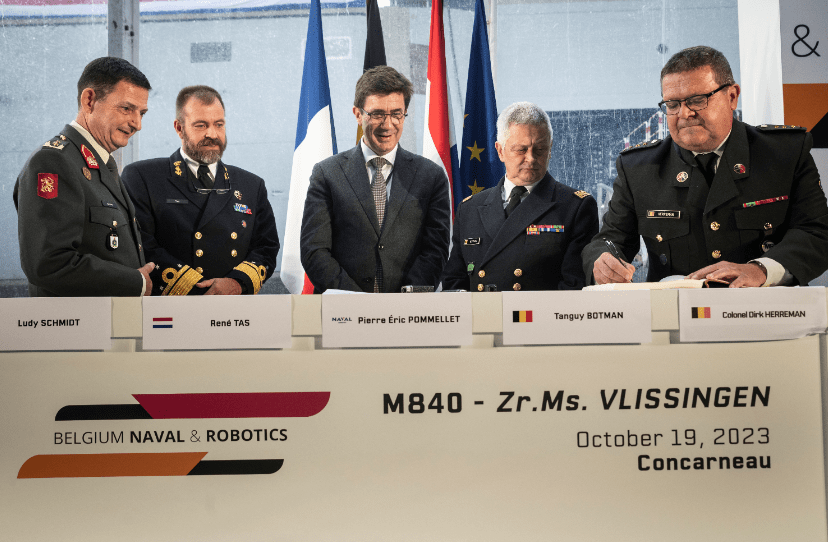
A robust vessel equipped with state-of-the-art technology
These specialized and cyber-secured by design mine countermeasures (MCM) vessels are pioneering their capability to carry and deploy a combination of surface drones (12-meter, 18-ton vessels), underwater drones, and aerial drones. The mine countermeasure vessels will primarily employ an autonomous system for detecting, classifying, and neutralizing mines. They are built to endure underwater detonations and have minimal acoustic, electrical, and magnetic signatures, in alignment with the missions they will undertake.
These mine countermeasure vessels have the subsequent specifications:
- Length: 82.6m
- Width: 17m
- Displacement: 2800t
- Maximum speed: 15.3 knots
- Range: >3500 nautical miles
- Crew: 63 personnel (base crew of 33 personnel)
- Drone capabilities: Exail UMISOFT System, 2 unmanned surface vessels (Exail Inspector 125), 3 autonomous underwater vehicles (A-18 fitted with Exail UMISAS 120 sonar), 2 towed sonars (T-18 equipped with Exail UMISAS 240 sonar), 2 Mine Identification & Disposal Systems (MIDS) systems (Exail Seascan and K-Ster C), 2 unmanned aerial vehicles (UMS Skeldar’s V200), and 1 Exail influence mine sweeping system integrating 5 CTM magnetic modules and 1 PATRIA acoustic module.
- Embarkation capacity: 2 SOLAS compliant rigid hull inflatable boats of 7m.
- Handling: 2 side launch & recovery systems for surface drones or commando boats, a dedicated 15t rear crane, and a 3t overhead crane.



